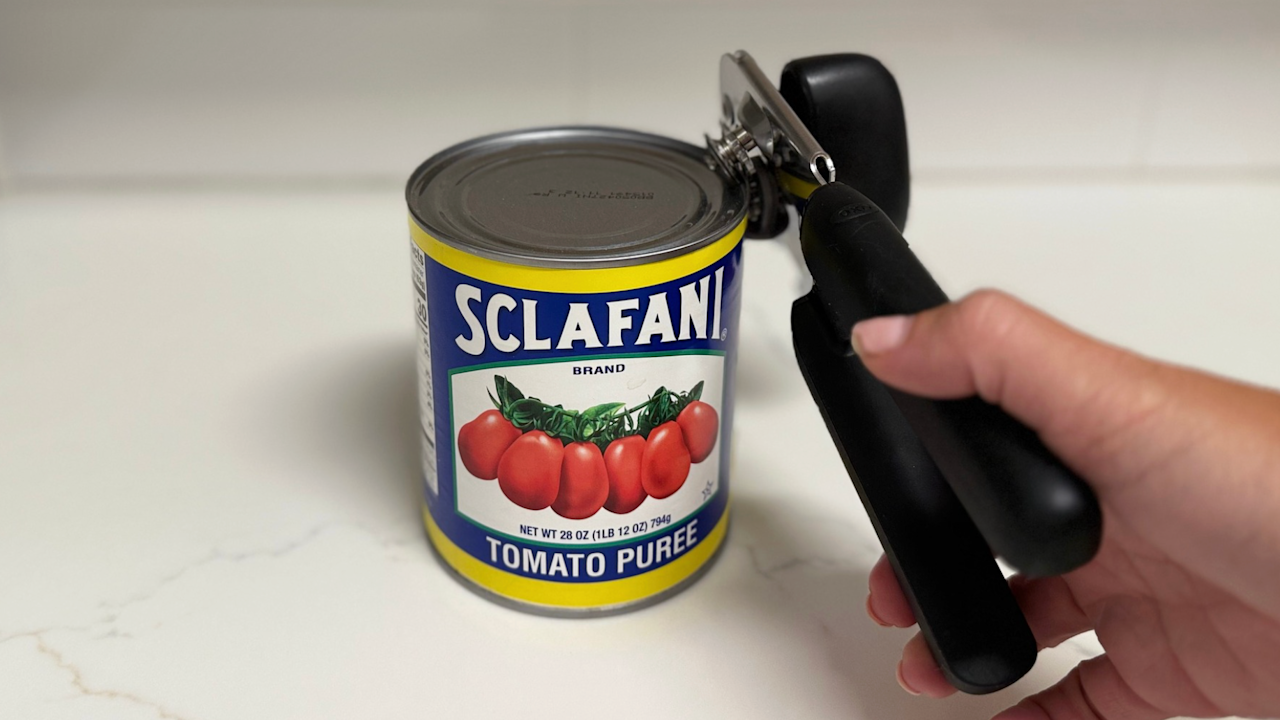
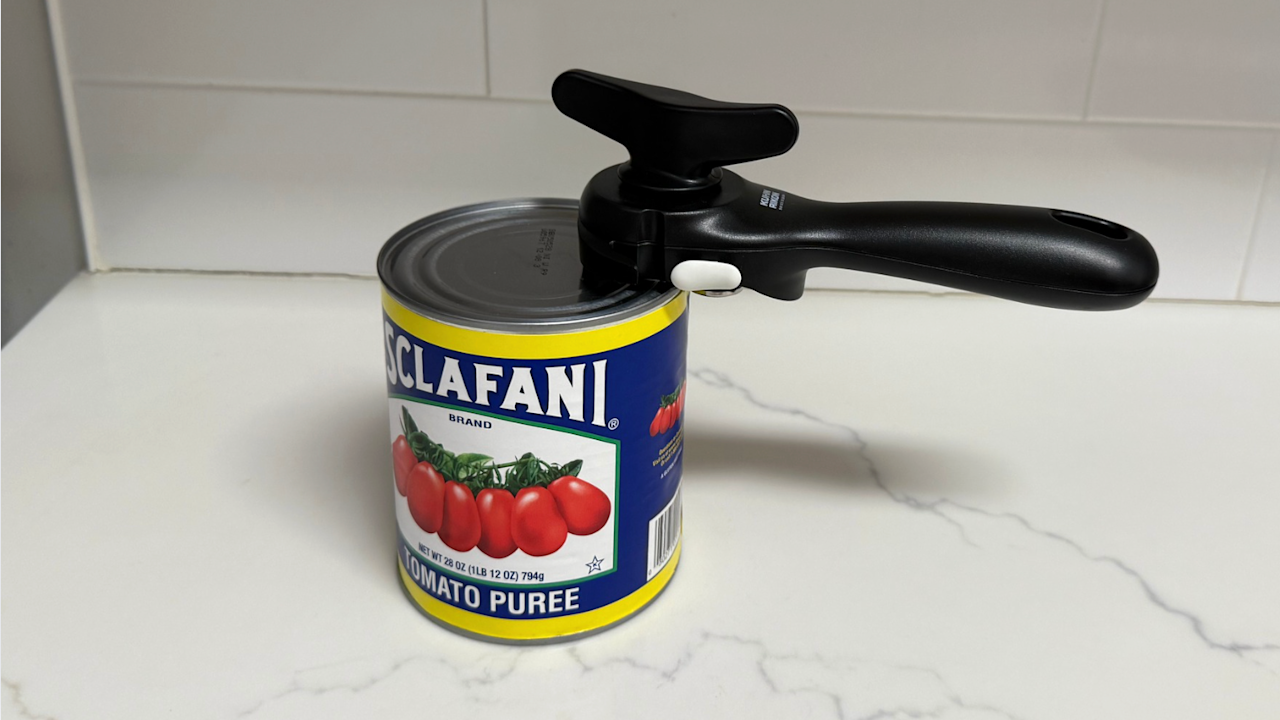
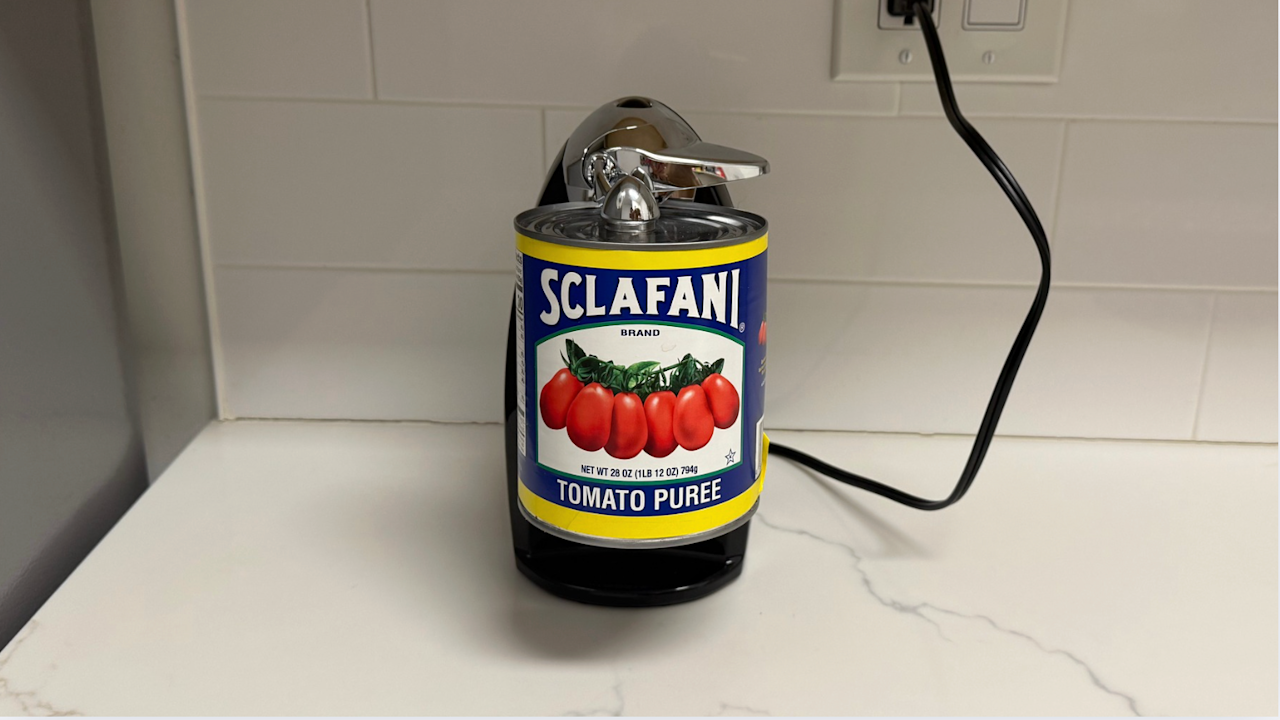
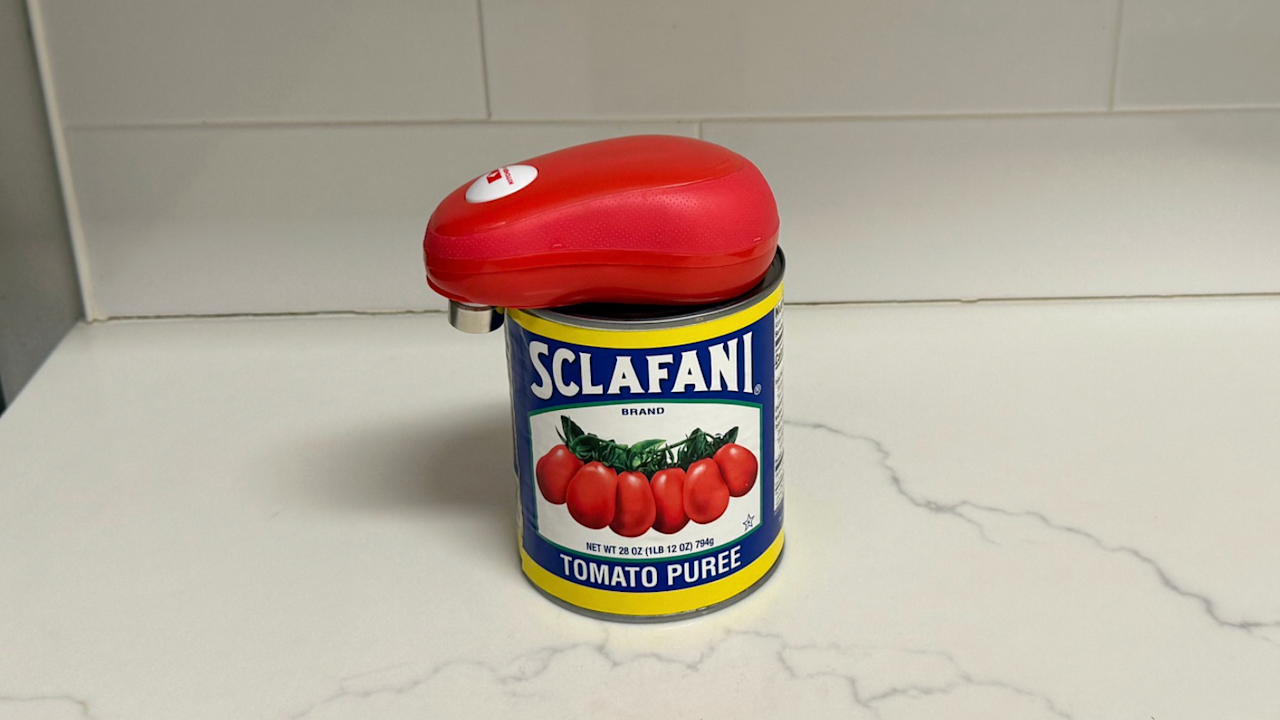
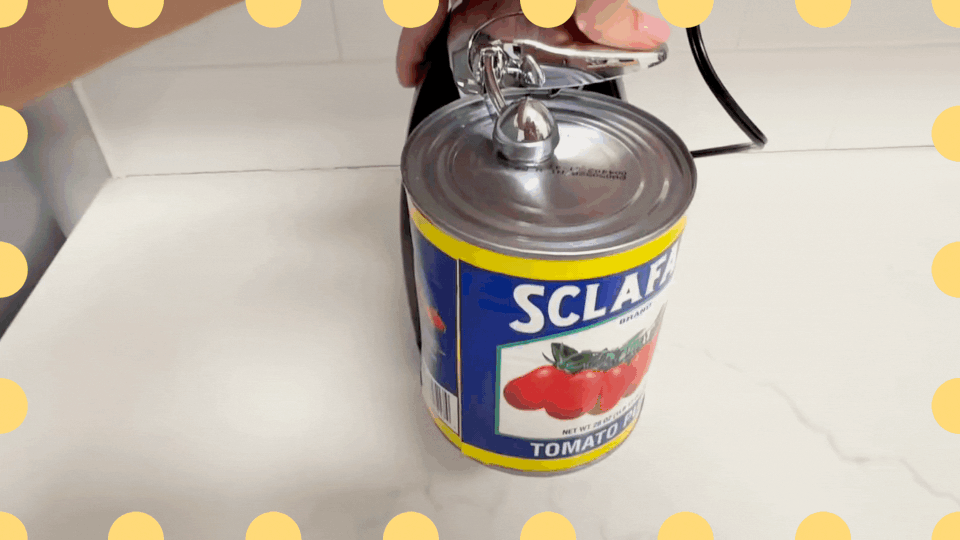
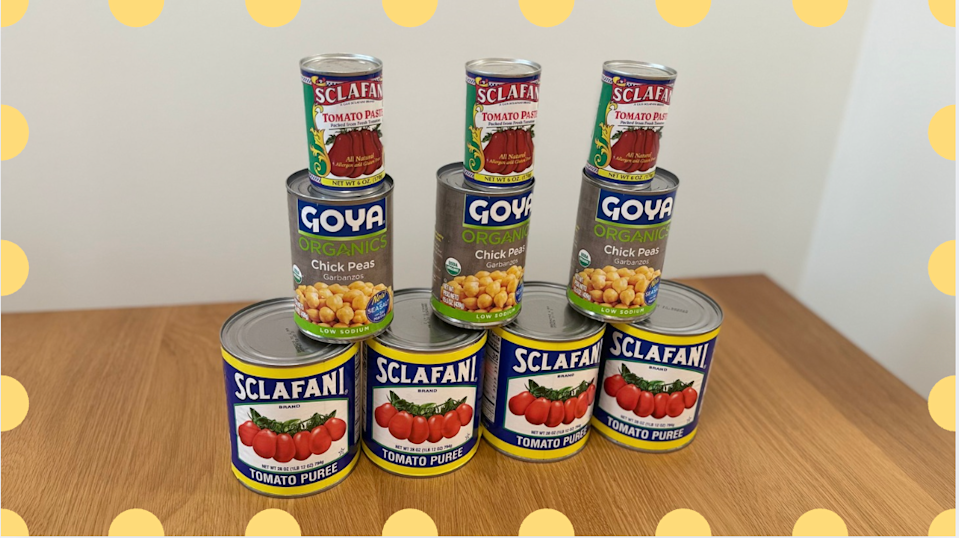

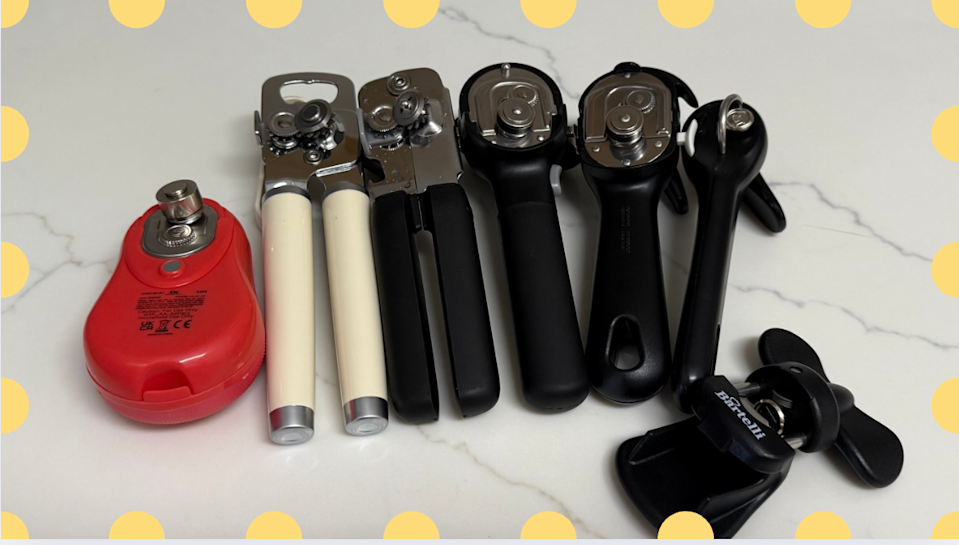
I can’t be the only one who groans at the thought of breaking out a can opener. It’s such an unassuming tool, but it somehow always manages to disappoint, whether it slips from my hands, snags a lid, stalls out mid-crank or all three. That’s not to mention the jagged can edges or the strain (and pain!) that can come with a cramped handle squeeze. Thankfully, the best can openers can offer some relief.
As a resident home writer at Yahoo, I’m no stranger to testing kitchen products, like vegetable choppers and air fryers, that are supposed to make cooking easier. The best can openers of 2025 do just that, cutting through lids with minimal exertion and record speed. For this review, I pitted 10 manual, electric and automatic can openers against cans of the same three sizes to see how smoothly and effortlessly I could get to the (saucy, soupy) goods. Here are the four that impressed me.
Table of contents
Best can openers of 2025

Kristin Granero/Yahoo
Size: 5″W x 5.91″H | Weight: 8.8 oz. | Type: Manual | Cut type: Top | Finishes: Black/chrome | Cleaning: Wipe clean
How it works: This is a traditional manual can opener that you crank. You position it so that the edge of the can is wedged between the cutting and notched wheels, with the knob facing outward. Then, push the handles together to clamp and puncture the can. Turning the knob clockwise advances the opener around the top of the can.
Why it’s great: I chose this as my top pick because, for a traditional can opener, it was incredibly effective and comfy to use. It took seven cranks of the knob to open small cans, eight to open medium cans and 13 to open large ones — in each case, the fewest cranks of any manual can opener I tested.
This workhorse also never went off course. I found the knob easy to crank, and the rubber handles cushy and secure. There’s also a bottle opener located under the knob for added function.
Who it’s for: Anyone who wants the control and quiet of a manual can opener, plus cushioned handles
- Comfortable non-slip grip
- Includes bottle opener
- Most affordable of our top picks
- Creates very sharp lid edges

Kristin Granero/Yahoo
Size: 2.75″W x 8″H | Weight: 5.6 oz. | Type: Manual | Cut type: Side | Finishes: Black, red and white | Cleaning: Wipe clean
How it works: This pick cuts around the side of a can (rather than the top) so the resulting lid’s edges are smoother. To use it, you position the can opener flat, face down on the can, so the cutting wheel is along the inner edge of the can and the larger, round cylinder is hugging the outer edge. Turn the knob clockwise to clamp the can opener, and then to rotate and cut around the can. Once you’ve gone a full circle (indicated by tiny perforations along the can’s inner rim), you turn the knob counterclockwise to release the opener from the can. Then, you can use the opener’s tiny built-in pliers to lift off the lid by pushing the button on the side.
Why it’s great: Kuhn Rikon is known for impressively sharp tools (both our editors and Ina Garten love the brand’s veggie peeler), and this gadget worked faster than any other manual side-cut can opener I tested. It took only seven cranks of the knob to open a small can, 11 for a medium can and 16 for a large.
It was also easy to attach and release it. Turning the knob was a breeze, and I appreciated how seamless it was to lift and remove lids. Speaking of the lids, the edges were fairly smooth, so I didn’t worry about accidentally cutting myself on them.
The model I tested features a hole in the handle for hanging. I also found this version with built-in jar and bottle openers for multitasking.
Who it’s for: Anyone who likes a manual can opener but is concerned about sharp or jagged lid edges
- Leaves behind smooth edges
- Features pliers for easily removing lids
- Requires a few more cranks than Oxo Good Grips

Kristin Granero/Yahoo
Size: 5.9″W x 10.24″H | Weight: 10.23 oz. | Type: Electric | Cut type: Top | Finishes: Black/chrome and red/chrome | Cleaning: Top part with blade is dishwasher-safe
How it works: This is a corded electric can opener, so you’ll need to plug it in. Hold your can up by the opener’s metal lever, then push the lever down so the magnetic lid holder (which looks like a little silver dome) “grabs” the can; simultaneously, the can opener’s blade will puncture the lid. Hold down the lever to rotate and cut the can. When finished, pull the can down and away from the blade to detach it from the machine.
Why it’s great: The thought of using an electric can opener might be intimidating (or at least it was for me), but this Hamilton Beach find makes it approachable and easy. It was among the fastest electric can openers I tried, zipping through small cans in five seconds, medium in eight and large in nine.
Despite its power, it emitted just a low hum. And it was convenient: Not only does the little magnetic dome latch onto and lift away the lid for you, but the upper portion that contains the blade pops off for easy, dishwasher-safe cleaning.
What else? The cord is retractable, and the back of the can opener includes a built-in knife sharpener. At only $28, it’s quite the bargain!
Who it’s for: Anyone with arthritis or grip issues, or who has safety concerns about touching sharp lids
- Easy operation (lifts lids away)
- Detachable blade is dishwasher-safe
- Cord is retractable
- Noisier than others on this list

Kristin Granero/Yahoo
Size: 4.72″W x 1.97″H | Weight: 10.23 oz. | Type: Electric | Cut type: Side | Finishes: Purple/white, red/white or teal/white | Cleaning: Wipe clean
How it works: This automatic can opener runs on batteries, so first, you’ll need to insert them. Then, you place the opener on top of your can so that the smaller cutting wheel sits along the inner edge and the larger wheel is along the outer edge. Once it’s secured, tap the white power button once and let the can opener do its thing.
Why it’s great: If you really don’t want to be bothered with opening cans, this gadget from Kitchen Mama is a godsend. With the AA batteries added and the can opener in position, I watched in amazement as this small but mighty pod managed to maneuver itself around cans of varying sizes, with expert precision, only stopping to rest when it was done.
It’s quick (rounding the largest can in about 38 seconds) and didn’t have any issues cutting cans of any size, including small tomato paste containers.
As this is a side-cut can opener, it leaves lid and can edges smooth for safer handling. It’s also fairly quiet, so you don’t need to worry about making a lot of noise if you’re using it at the office or if someone in the house is sleeping.
Who it’s for: Anyone who’d rather be hands-off for this kitchen task and/or is tight on space
- Quiet, hands-free operation
- Leaves behind smooth edges
- Easy to spot in a drawer or cabinet
- Compact size
- Requires four AA batteries (and they’re not included)
- On the pricer side

How to choose a can opener
Here are some things to keep in mind when it comes to selecting the best can opener for you.
Can opener type
Manual (or rotary): This type tends to be the most common and affordable. It’s also generally quiet and portable. However, it’ll require more effort (and typically, time) to crank and therefore rotate/cut around each can. In my experience, manual can openers also more likely to skip areas or slip off, especially if you don’t have a very steady hand.
Electric: Powered by a cord or batteries, this type does most of the work for you. Just clip (or clamp) a can in place and hold down a button or lever to rotate and cut the can (some machines also lift the lid for you when finished). If you have an automatic version, the rotating and cutting will happen with the push of a button. The drawbacks are that electric can openers can be on the pricey side and they can get loud.
Cut type
Top-cut: With this type, the cutting wheel punctures and cuts around the top of the can. The benefit is that it’s easier to see where the can has been sliced, and therefore when you’ve made a full rotation. That said, the lid and can edges tend to be rougher. I’ve also found that lids often fall into the cans when detached, which can be messier.
Side-cut: In this case, the cutting wheel slices into the side of the can. It can be harder to see where you are cutting, but the lids stay intact, so you can lift them away when finished (versus having to fish around inside a can of food). This style tends to result in smoother lid and can edges.
Versatility
Some of the can openers I tested feature pliers for grabbing and lifting lids. Others moonlight as bottle openers or knife sharpeners, offering more functionality for the cost and proving helpful for those who wants to reduce the amount of tools in their life.

Fully stocked: For my evaluation, I tested can openers against three can sizes to see how well they could navigate each. (Kristin Granero/Yahoo)
How we tested these can openers
I stocked up on cans in three sizes — small (2.2 inches across), medium (3 inches across) and large (4 inches across). For the medium-sized can, I chose an option with a pull tab, as certain foods are now only available with this option, and I and wanted to see how well the can openers could navigate them should someone still want to go the old-fashioned route.
I then tested each can opener against the cans to see how easily, quickly and smoothly the gadgets worked. Additionally, I cleaned each can opener according to the manufacturer’s instructions to gauge difficulty. I also took notes on factors like comfort, safety and affordability, as well as a given can opener’s multitasking abilities.

Other can openers we tested
Discover how other brands stacked up when it came to my towering mountain of cans.
KitchenAid Classic Multifunction Manual Can Opener: This top-cut can opener looks and functions like our top Oxo pick, resulting in a similarly rough — but not jagged — cut. It got the job done in about as many knob turns (one more for medium- and large-size cans). It also features a bottle opener. In the end, I chose Oxo Good Grips as my top pick because I found the handles to be slightly grippier, and it was $1 less.
Oxo Good Grips Smooth Edge Manual Can Opener: Like the Kuhn Rikon Auto Safety Master Can Opener, this can opener is affixed to the side of a can, operates manually, and comes with built-in pliers for lifting lids (and it retails for the same price). It required two more turns to get around each of the medium and large cans, but had a slightly more stable grip than the Kuhn Rikon.
GoodCook Safe Cut Manual Can Opener: GoodCook’s compact $10 can opener makes side cuts similar to our top Oxo Good Grips and Kuhn Rikon models, but without the rubber handle for gripping, the built-in loop for hanging or the built-in pliers featured in both. It took me an average of two to three additional turns of the knob to make its way around the cans, but it does the trick — and leaves lid edges smooth.
Bartelli Soft Edge 3-in-1 Can Opener: This manual side-cut can opener differs from the others I tested in that it doesn’t have a handle, but rather a stabilizing piece that sits atop the can as you turn a knob clockwise, along the outer edge. It took 14 turns to get around a medium-size can, and 20 turns — more than any other manual opener — to get around a large-size can. The top piece proved too large to use on the small tomato paste can.
Cuisinart CCO-55 Deluxe Electric Can Opener: Cuisinart’s take on the electric can opener is legit. It works like my top electric pick in that it cuts the top of the can and has a magnetic piece that latches onto and lifts the lid. It’s also similar in speed and noise. But it’s about $10 more than the Hamilton Beach Electric Automatic Can Opener and doesn’t have a cord keeper or knife sharpener. You also can’t detach the blade portion for cleaning.
Hamilton Beach Smooth Touch Electric Automatic Can Opener: This can opener deviates from the other electric versions I tested in that it cuts cans on the side. You press down on the top of the appliance to rotate and cut, which was easy and comfortable. The cut is smoother, and in my opinion, the grip is slightly more stable. However, you’ll need to lift the can lid off yourself. This opener also took a few more seconds to work, was a tinge louder and costs slightly more than the other electric options.

About face: With top-cut can openers (like the two-handled ones shown), the cutting wheel punctures the top of the can. With the side-cut can openers, the cutting wheel perforates around the side to dismantle the full rim. (Kristin Granero/Yahoo)
Can opener FAQs
How do I use a can opener?
A can opener typically works by clamping a can between two wheels — one for cutting and one for rotating — either cutting along the top or side of the can. With manual can openers, you turn a knob (usually clockwise) to clamp and then rotate/cut around. With electric can openers, you press a button or hold a lever to rotate/cut.
How do I clean a can opener?
Carefully! You’ll want to avoid touching the cutting wheel (or blade) of a can opener, as well as any other sharp parts, when cleaning it. Many of the brands I tested recommended wiping down their can openers with a damp towel. You can also look for can openers with dishwasher-safe components for added convenience.
What’s the best can opener for seniors?
If you lack hand strength or are dealing with arthritis or any other age-related issues, an electric can opener is probably best because it does most of the work for you. When it comes to manual can openers, top-cut openers offer more visibility (because they cut through the top edges of the can, it’s easier to see when the can is ready). Side-cut openers, on the other hand, leave behind a smoother edge. Because the lids don’t tend to fall in like they often do with top-cut openers, they’re easier (and, in my experience, safer) to lift and remove.
We received complimentary samples of some products and purchased others ourselves, but we reviewed all products using the same objective criteria.
Source link
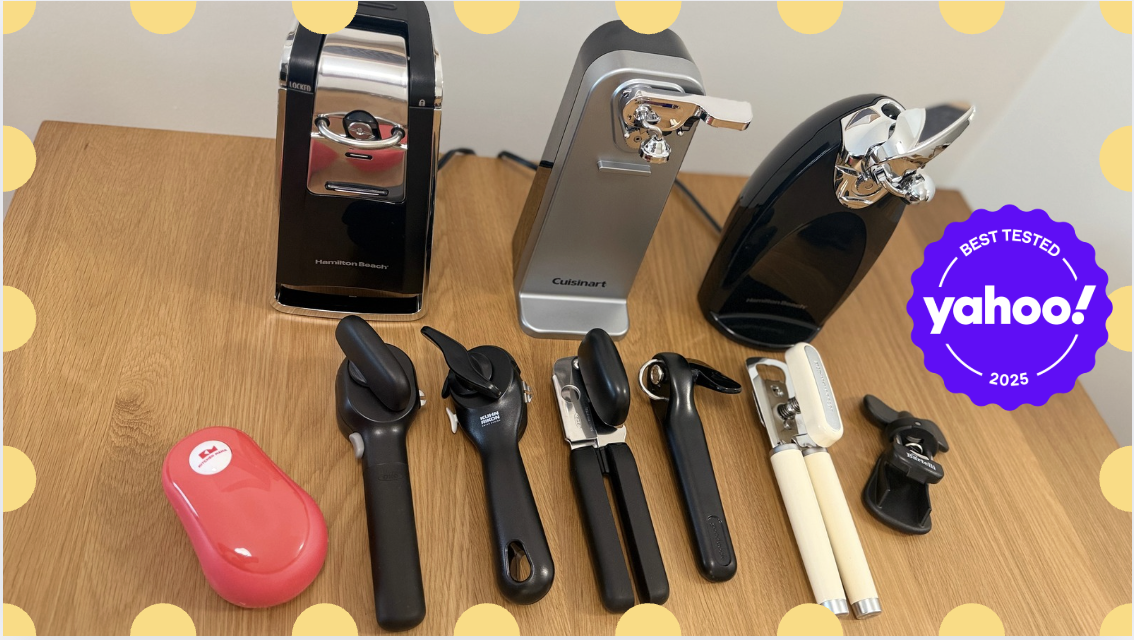
اترك تعليقاً